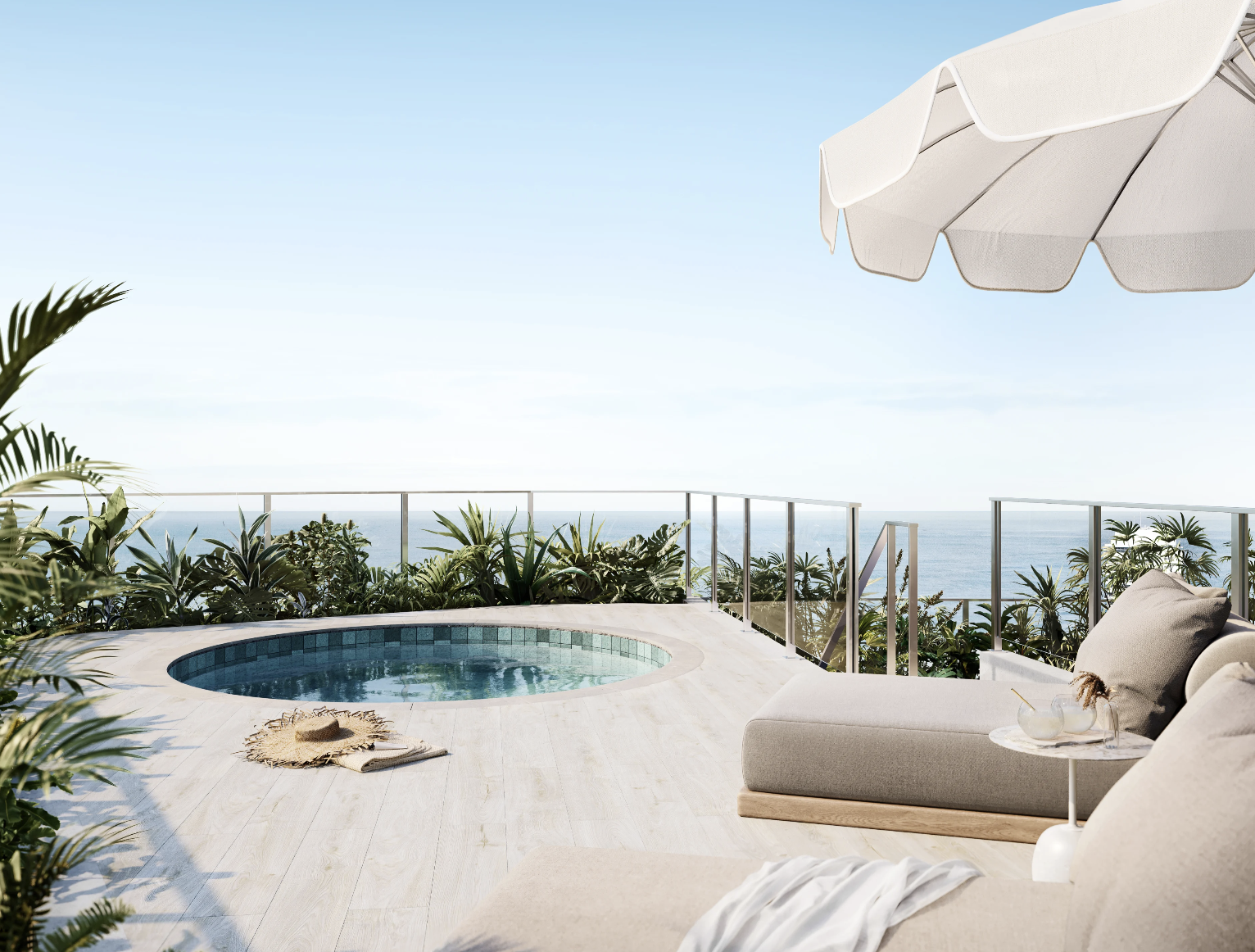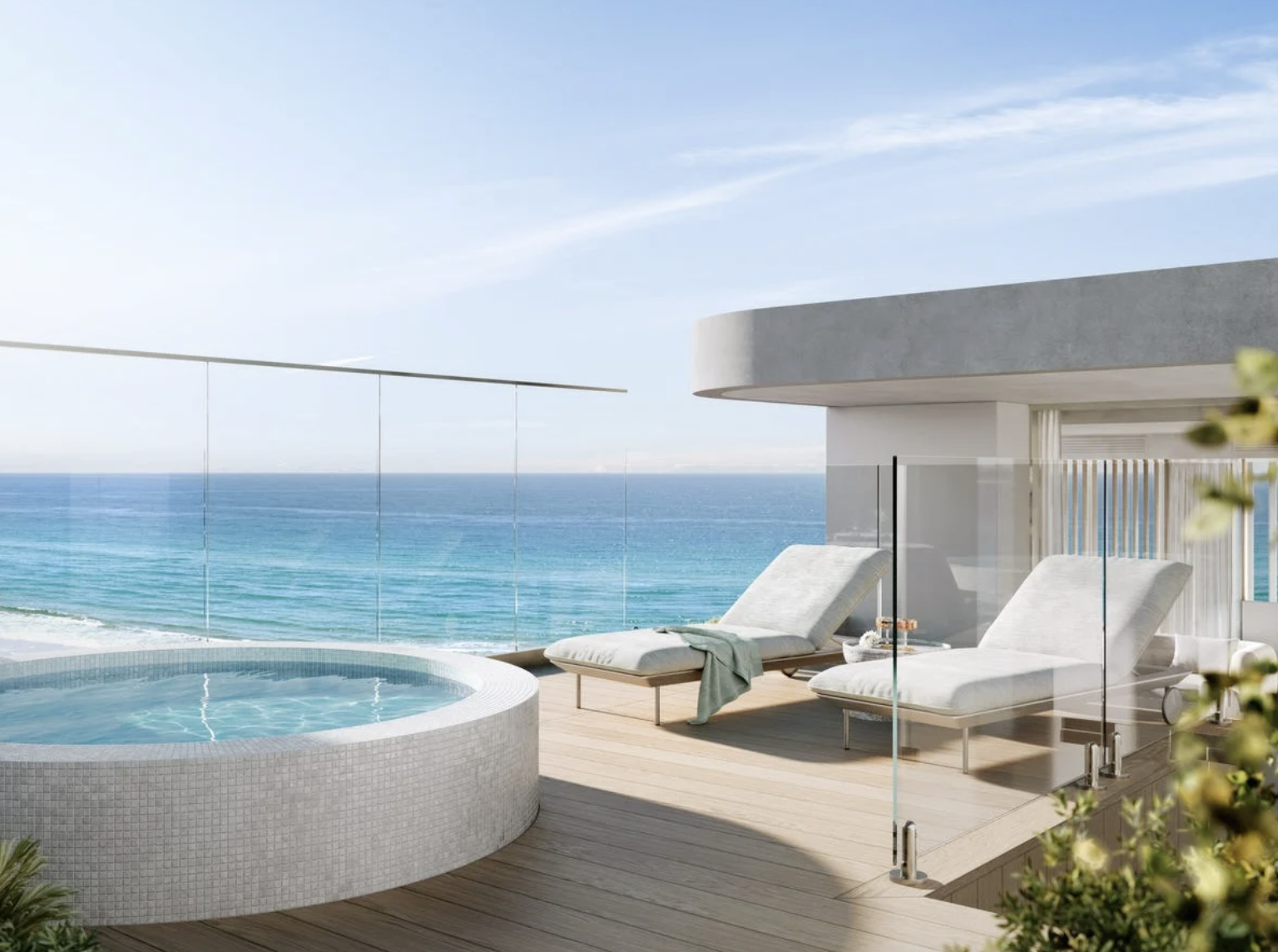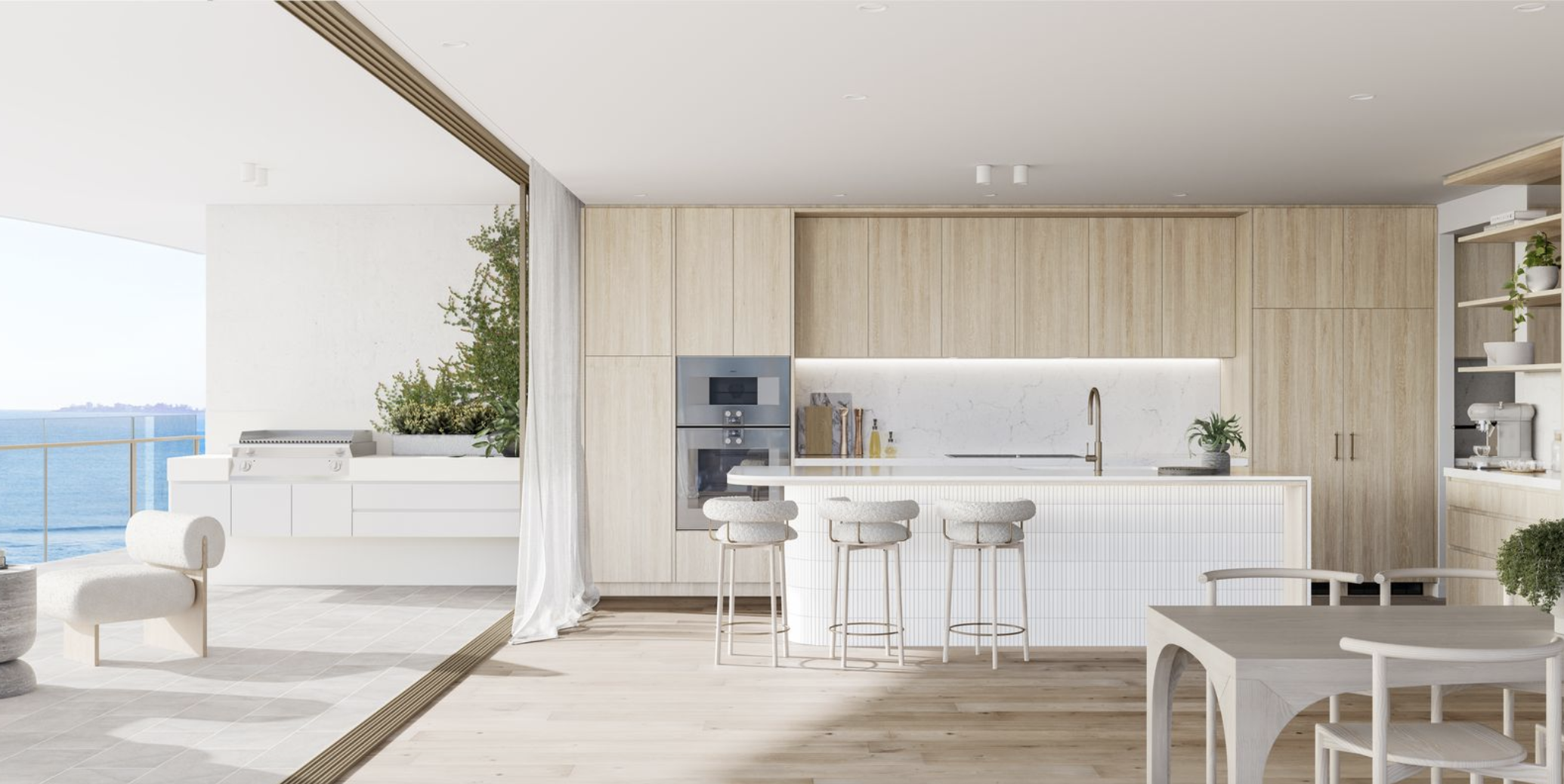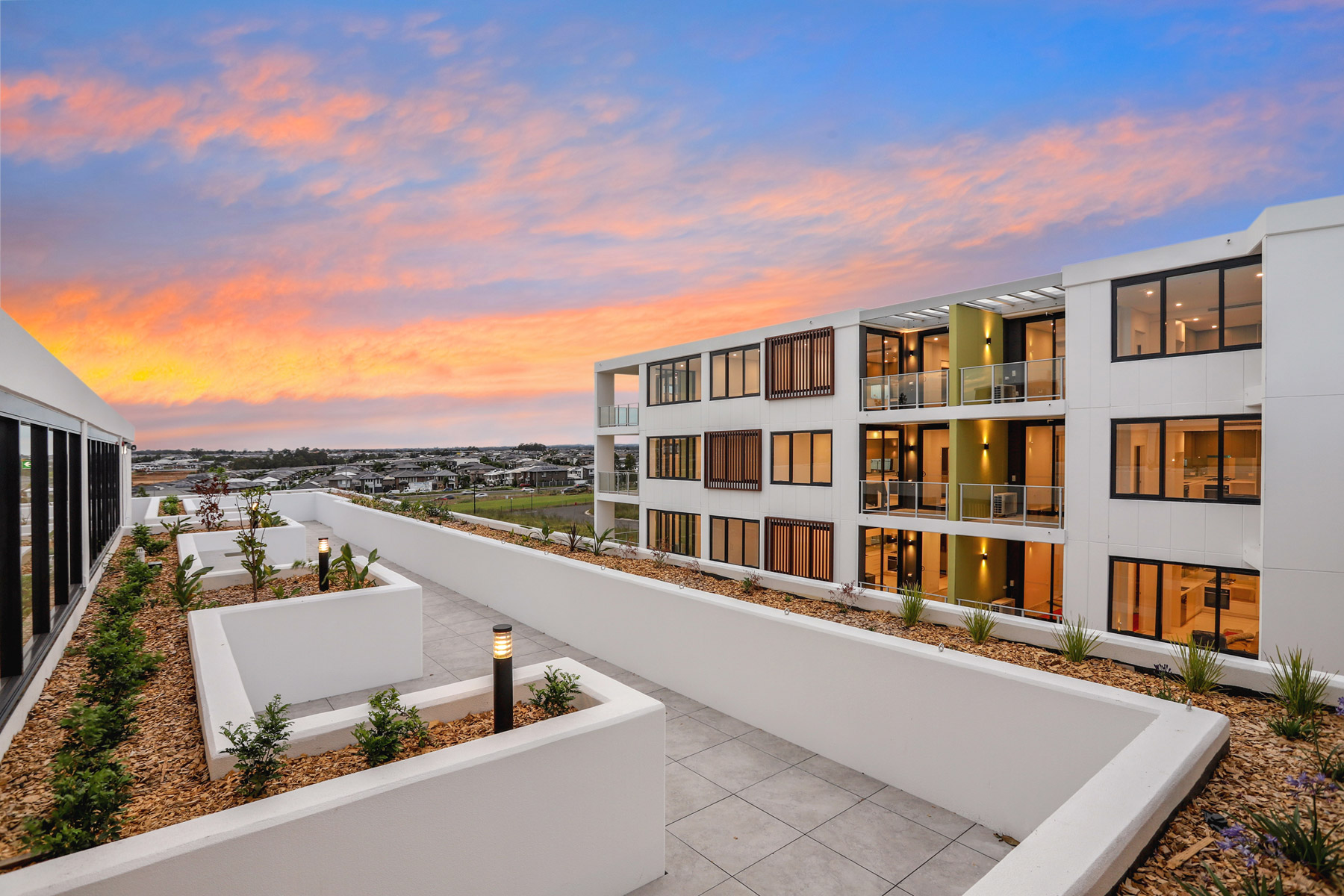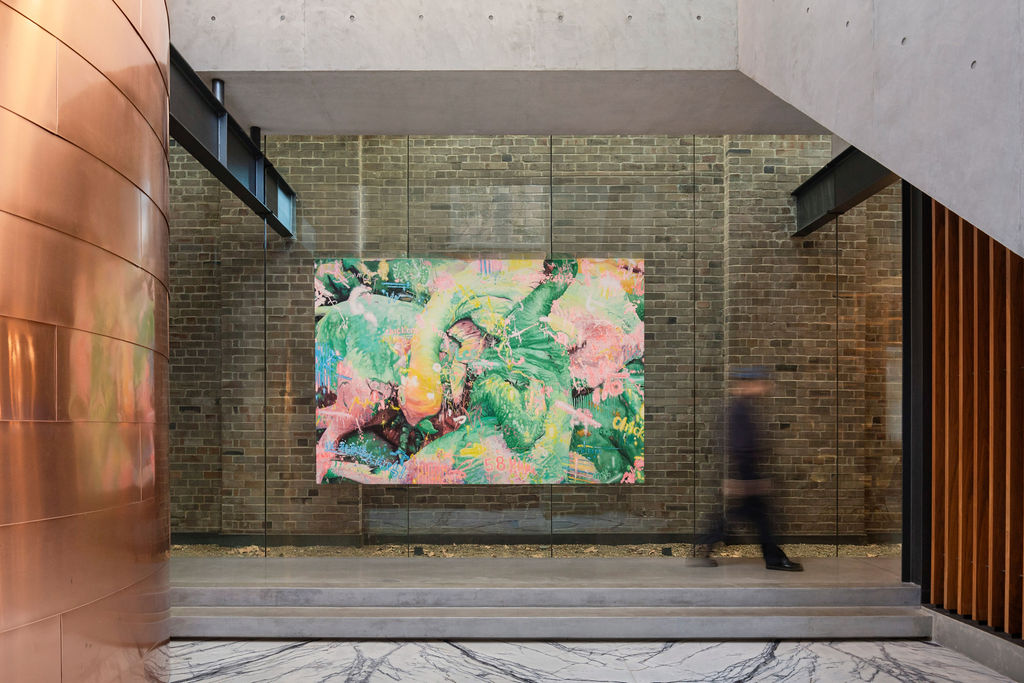Gold Coast’s Five Standout Penthouses for 2025
From Main Beach to Palm Beach, the Gold Coast is setting a new benchmark for sky-high luxury. We highlight five standout penthouses redefining coastal living in 2025.
The calibre of penthouse apartments on the Gold Coast has skyrocketed in recent years. The pandemic truly shone a light on the lifestyle and livability of the Gold Coast – a gem long overlooked, particularly by those from the southern States.
But now, well-heeled buyers from Sydney and Melbourne are casting their eyes north, looking to the Coast for retirement, or at the very least, a luxurious holiday base to escape the cold southern winters.
These buyers, who won’t get much change out of $8 million when shopping for a sky-high home along the Glitter Strip, expect all the bells and whistles. A private pool is a must, as are top-of-the-line appliances, natural stone finishes, and, of course, sweeping ocean views.
Gold Coast developers have answered the call, delivering some of the finest apartments on the East Coast. From Main Beach to Palm Beach, here are five standout penthouses currently on the market.
Lagoon, Main Beach. Developer: Drew Group
One of the largest developments Main Beach has ever seen is nearing completion, and the final residences, The Signature Collection, include several sub-penthouses and penthouses that will be “hard to replicate.”
“The unrepeatable nature of these apartments hasn’t been lost on buyers,” says Drew Group Managing Director Jon Drew. “It will be hard to replicate the sheer size of these apartments. No expense has been spared to create these luxurious sub-penthouses and penthouses. At this price point, it’s an opportunity that may never be repeated in a new Main Beach development.”
The penthouse atop the Sunrise tower is the highest apartment in the dual-tower project. Priced at $7.15 million, the Sunrise Penthouse spans 460 sqm and features four bedrooms, four bathrooms, and three-car parking.
It offers sweeping views of the ocean, Gold Coast skyline, and hinterland from the kitchen, living, and dining areas. The kitchen includes Gaggenau appliances and natural stone benchtops, complemented by a wine cellar, bar area with Vintec wine fridge, and a private heated rooftop pool with an adjoining outdoor BBQ kitchen.
Lagoon’s name nods to its lagoon-style central swimming pool, available to all residents. They also have access to a podium-level entertainment lounge and garden with designer cooking stations, a fitness centre with adjoining yoga terrace, a 24/7 connected boardroom, and dedicated workspaces.
Pipis, Bilinga. Developer: SIERA
One of the penthouses crowning SIERA’s absolute beachfront development, Pipis, is expected to set a new Bilinga record, with pricing around $8.5 million.
There are two penthouses atop the 11-level Golden Four Drive building – SIERA’s first Gold Coast development after moving up from Brisbane.
The two-level residences each span 446 sqm of internal and external space, designed by Ellivo Architects. Each features four bedrooms and is finished with high-end materials including natural stone, Navurban Balmoral and Plytec Blossom joinery, and white-oiled natural timber flooring.
Kitchens are appointed with premium appliances, including an induction cooktop, steam oven, speed oven, ZIP tap, InSinkErator, built-in coffee machine, and a butler’s pantry with wine cellar.
A sculptural spiral staircase serves as a dramatic centrepiece, while a private lift also connects the levels. On the rooftop, residents will find a private plunge pool and sun deck with ocean views.
Residents are expected to move into Pipis in the coming months.
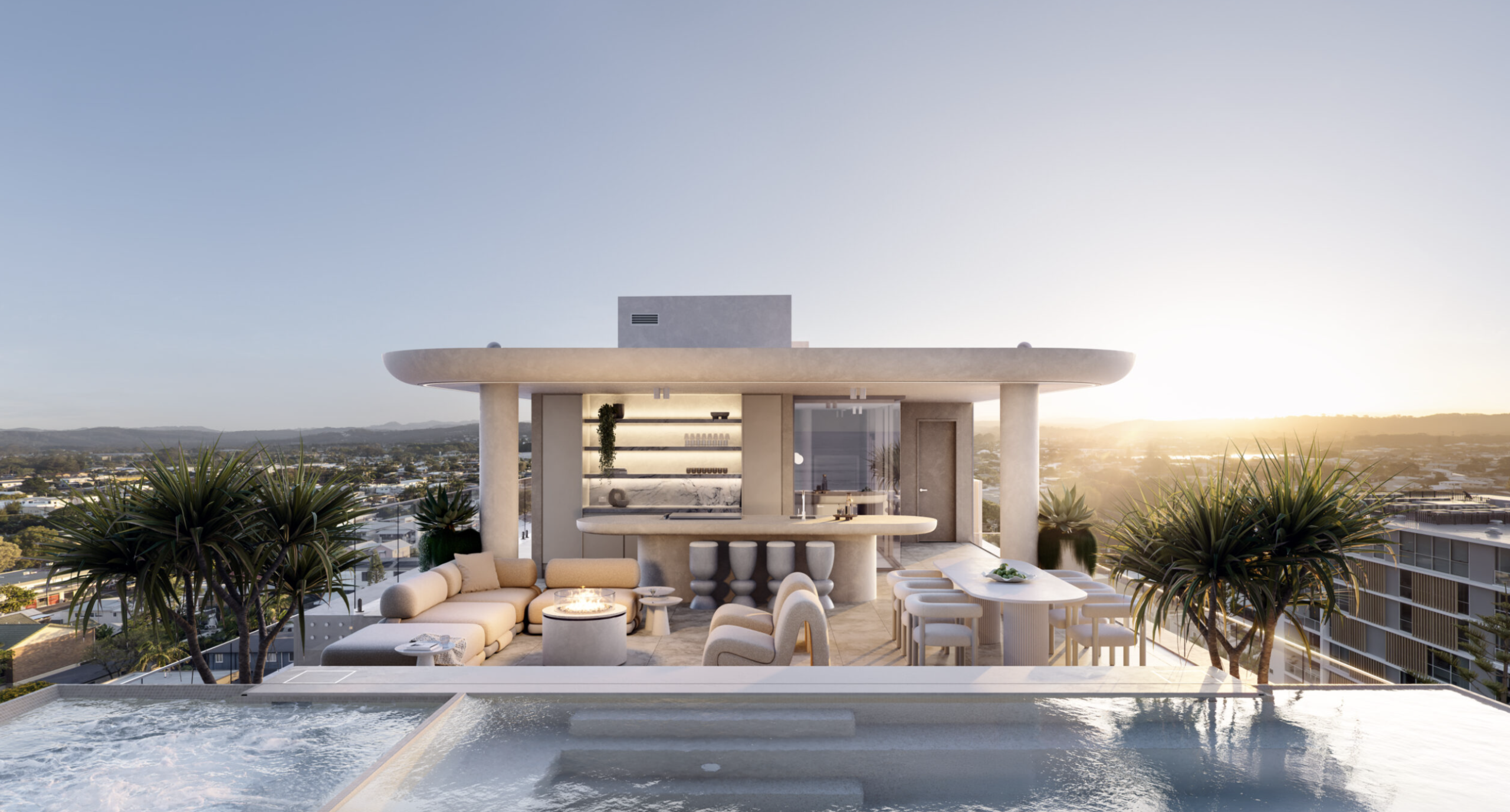
Kloud, Palm Beach. Developer: GRAYA
There’s arguably no better address in Palm Beach than Jefferson Lane – and luxury Brisbane-based developer GRAYA clearly agrees.
“When selecting a site, we look closely at all of the fundamentals — demand, future infrastructure investment, and lifestyle,” said Graya Managing Director Rob Gray.
“After carefully assessing these criteria, it was a no-brainer when selecting Palm Beach as the ideal location for our next multi-residential development.”
Local site specialists, GV Property Group, amalgamated a prized 824 sqm block, which will soon be home to Kloud, a boutique 10-level project with just 20 apartments, ranging from two to four bedrooms.
Topping the building is a 507 sqm, two-level penthouse with four bedrooms, five bathrooms, and three parking spaces. Finishes include European oak flooring, fluted stone, curved walls, and soft, tonal hues that reflect the coastal setting.
The top level is devoted entirely to entertaining, featuring a covered alfresco space with bar, lounge area with firepit, and a private pool and spa.
The penthouse is priced at $8.95 million, with completion due later this year.
La Belle, Palm Beach. Developer: Marquee Development Partners
While Jefferson Lane may be the crown jewel of Palm Beach, The Esplanade is a very close second. Marquee secured a premium 3,300 sqm beachfront parcel from former world motorcycle champion Mick Doohan, and from it launched La Belle — their 11th Gold Coast apartment project.
More than 80% of the 75 apartments have sold, and late last year, Marquee unveiled the Penthouse Collection: 10 sub-penthouses and the flagship Grand Penthouse.
“We’re beyond excited to unveil what we believe will be the pinnacle of penthouse living on the Southern Gold Coast,” said Marquee Director Jacques Winterburn.
“Our commitment to creating exceptional spaces where every detail elevates the living experience is what makes this collection truly unparalleled.”
The Grand Penthouse offers 520 sqm of internal living and an additional 162 sqm of outdoor space. It includes five bedrooms, four and a half bathrooms, a multi-purpose room, four car parks, an indoor cinema, a wine display, a large home office, and a statement fireplace.
Residents will have access to 1,500+ sqm of wellness and lifestyle amenities, including a heated outdoor pool and spa, teppanyaki bars, private offices, a resident lounge with billiards and bar, and a world-class wellness centre with infrared and Nordic saunas, a hydrotherapy pool, and dual cold plunge baths.
La Belle is slated for completion in mid-2026.
Perspective Helm, Chevron Island. Developer: Sherpa Property Group
Chevron Island isn’t typically known for boutique ultra-luxury, but Sherpa Property Group’s waterfront project, Perspective Helm, is a standout exception.
Penthouse 10 recently sold for around $10 million to a Brisbane couple, setting a new record for the island.
Just one residence remains — Penthouse Nine — priced at $9.99 million. It spans nearly 800 sqm over two levels and includes four bedrooms, four bathrooms, a cinema, a multi-purpose room, and a secure four-car garage.
The penthouse also features a rooftop pool alongside a full outdoor kitchen with BBQ, pizza oven, firepit, and lounge area — plus a 60-foot private marina berth.
“Every detail of these penthouses has been meticulously crafted to offer an indulgent lifestyle, where effortless luxury meets serene sophistication,” said Sherpa CEO Christie Leet.
“We’re seeing strong interest from downsizers drawn to the quality and convenience of this location. The combination of true riverfront living and marine access is rare, and it’s clearly resonating with the market.”
Records keep falling in 2025 as harbourfront, beachfront and blue-chip estates crowd the top of the market.
A divide has opened in the tech job market between those with artificial-intelligence skills and everyone else.
The 2026 McGrath Report warns that without urgent reforms to planning, infrastructure and construction, housing affordability will continue to slip beyond reach for most Australians.
Australia’s housing market has reached a critical juncture, with home ownership and rental affordability deteriorating to their worst levels in decades, according to the McGrath Report 2026.
The annual analysis from real estate entrepreneur John McGrath paints a sobering picture of a nation where even the “lucky country” has run out of luck — or at least, out of homes.
New borrowers are now spending half their household income servicing loans, while renters are devoting one-third of their earnings to rent.
The time needed to save a 20 per cent deposit has stretched beyond ten years, and the home price-to-income ratio has climbed to eight times. “These aren’t just statistics,” McGrath writes. “They represent real people and real pain.”
McGrath argues that the root cause of Australia’s housing crisis is not a shortage of land, but a shortage of accessibility and deliverable stock.
“Over half our population has squeezed into just three cities, creating price pressure and rising density in Sydney, Melbourne and Brisbane while vast developable land sits disconnected from essential infrastructure,” he says.
The report identifies three faltering pillars — supply, affordability and construction viability — as the drivers of instability in the current market.
Developers across the country, McGrath notes, are “unable to make the numbers work” due to labour shortages and soaring construction costs.
In many trades, shortages have doubled or tripled, and build costs have surged by more than 30 per cent, stalling thousands of projects.
Need for systemic reform
McGrath’s prescription is clear: the only real solution lies in increasing supply through systemic reform. “We need to streamline development processes, reduce approval timeframes and provide better infrastructure to free up the options and provide more choice for everyone on where they live,” he says.
The 2026 edition of the report also points to promising trends in policy and innovation. Across several states, governments are prioritising higher-density development near transport hubs and repurposing government-owned land with existing infrastructure.
Build-to-rent models are expanding, and planning reforms are gaining traction. McGrath notes that while these steps are encouraging, they must be accelerated and supported by new construction methods if Australia is to meet demand.
One of the report’s key opportunities lies in prefabrication and modular design. “Prefabricated homes can be completed in 10–12 weeks compared to 18 months for a traditional house, saving time and money for everyone involved,” McGrath says.
The report suggests that modular and 3D-printed housing could play a significant role in addressing shortages while setting a new global benchmark for speed, cost and quality in residential construction.
Intelligent homes
In a section titled Weathering the Future: The Power of Smart Design, the report emphasises that sustainable and intelligent home design is no longer aspirational but essential.
It highlights new technologies that reduce energy use, improve thermal efficiency, and make homes more resilient to climate risks.
“There’s no reason why Australia shouldn’t be a world leader in innovative design and construction — and many reasons why we should be,” McGrath writes.
Despite the challenges, the tone of the 2026 McGrath Report is one of cautious optimism. Demand is expected to stabilise at around 175,000 households per year from 2026, and construction cost growth is finally slowing. Governments are also showing a greater willingness to reform outdated planning frameworks.
McGrath concludes that the path forward requires bold decisions and collaboration between all levels of government and industry.
“Australia has the land, demand and capability,” he says. “What we need now is the will to implement supply-focused solutions that address root causes rather than symptoms.”
“Only then,” he adds, “can we turn the dream of home ownership back into something more than a dream.”
An opulent Ryde home, packed with cinema, pool, sauna and more, is hitting the auction block with a $1 reserve.
Ophora Tallawong has launched its final release of quality apartments priced under $700,000.










